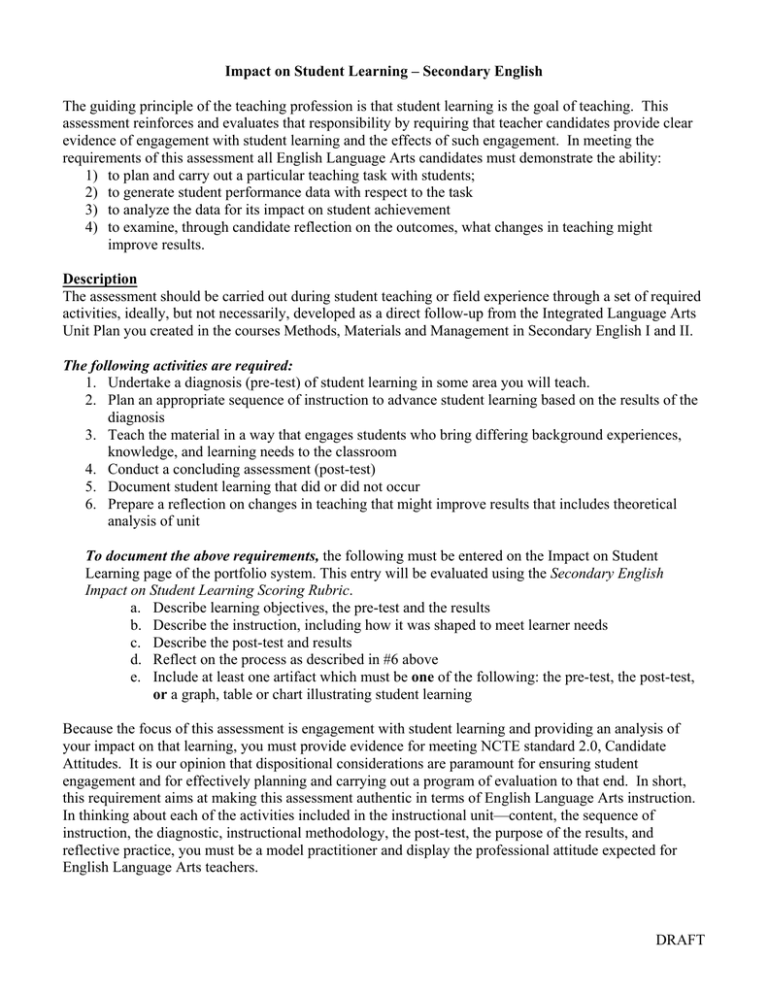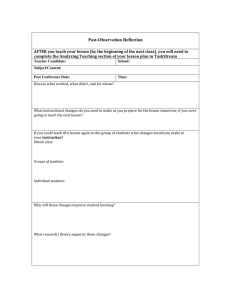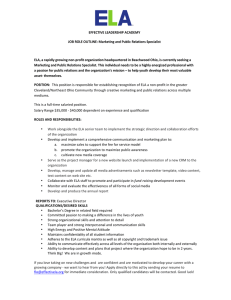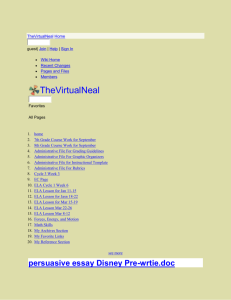The guiding principle of the teaching profession is that student... Impact on Student Learning – Secondary English
advertisement

Impact on Student Learning – Secondary English The guiding principle of the teaching profession is that student learning is the goal of teaching. This assessment reinforces and evaluates that responsibility by requiring that teacher candidates provide clear evidence of engagement with student learning and the effects of such engagement. In meeting the requirements of this assessment all English Language Arts candidates must demonstrate the ability: 1) to plan and carry out a particular teaching task with students; 2) to generate student performance data with respect to the task 3) to analyze the data for its impact on student achievement 4) to examine, through candidate reflection on the outcomes, what changes in teaching might improve results. Description The assessment should be carried out during student teaching or field experience through a set of required activities, ideally, but not necessarily, developed as a direct follow-up from the Integrated Language Arts Unit Plan you created in the courses Methods, Materials and Management in Secondary English I and II. The following activities are required: 1. Undertake a diagnosis (pre-test) of student learning in some area you will teach. 2. Plan an appropriate sequence of instruction to advance student learning based on the results of the diagnosis 3. Teach the material in a way that engages students who bring differing background experiences, knowledge, and learning needs to the classroom 4. Conduct a concluding assessment (post-test) 5. Document student learning that did or did not occur 6. Prepare a reflection on changes in teaching that might improve results that includes theoretical analysis of unit To document the above requirements, the following must be entered on the Impact on Student Learning page of the portfolio system. This entry will be evaluated using the Secondary English Impact on Student Learning Scoring Rubric. a. Describe learning objectives, the pre-test and the results b. Describe the instruction, including how it was shaped to meet learner needs c. Describe the post-test and results d. Reflect on the process as described in #6 above e. Include at least one artifact which must be one of the following: the pre-test, the post-test, or a graph, table or chart illustrating student learning Because the focus of this assessment is engagement with student learning and providing an analysis of your impact on that learning, you must provide evidence for meeting NCTE standard 2.0, Candidate Attitudes. It is our opinion that dispositional considerations are paramount for ensuring student engagement and for effectively planning and carrying out a program of evaluation to that end. In short, this requirement aims at making this assessment authentic in terms of English Language Arts instruction. In thinking about each of the activities included in the instructional unit—content, the sequence of instruction, the diagnostic, instructional methodology, the post-test, the purpose of the results, and reflective practice, you must be a model practitioner and display the professional attitude expected for English Language Arts teachers. DRAFT Secondary English Impact on Student Learning Scoring Guide Directions for Evaluators: Please use the following performance scale to indicate the candidate’s ability to meet the specific performance criteria (Required Assessment Activity) listed below for the aligned NCTE standards Needs Improvement (1) Acceptable (2) Target (3) Performance task requirements, criteria, and/or levels of performance are not sufficient or do not appear to cover the elements of identified standards or data provided do not offer convincing evidence of having a sufficient content knowledge base to meet the ELA content standard listed. Performance task requirements, criteria, and/or levels of performance appear sufficient to cover the elements of identified standards, and data provided offer convincing evidence of having a sufficient content knowledge base to meet the ELA content standard listed. Strong performance task requirements, criteria, and/or levels of performance are more than sufficient to cover the elements of the identified standards, and the data provided offer evidence of high levels of candidate performance that, in turn, suggests an in-depth content knowledge base for candidates Required Assessment Activity NCTE Standard(s) undertakes an effective diagnosis (pre-test) of student learning in some area the candidate will teach which: demonstrates knowledge of students’ language acquisition and development 3.1.1 plans an appropriate sequence of instruction to advance student learning which: assists students in developing habits of critical thinking makes meaningful connections between the ELA curriculum and developments in culture, society, and education uses instructional materials that are consistent with what is currently known about student learning in ELA integrates assessment consistently into instruction by establishing criteria and developing strategies for assessment that allow all students to understand what they know and can do in light of their instructional experiences 2.4, 2.5, 4.1, 4.1 (a) teaches the material in a way that engages students who bring differing background experiences, knowledge, and learning needs to the classroom by: creating an inclusive and supportive learning environment in which all students can engage in learning using ELA to help their students to become familiar with their own and others’ cultures engaging all students in reading, writing, speaking, listening, viewing, and thinking as interrelated dimensions of the learning experience in ELA employing effective classroom management strategies with varied structures and techniques for group interactions and opportunities for feedback and reflection 2.1, 2.2, 3.1.2, 4.2 conducts a concluding assessment (post-test) which: assesses reading, writing, speaking, listening, viewing, and thinking as interrelated dimensions of the learning experience in ELA assesses the effectiveness of strategies to interpret, evaluate, and appreciate texts in promoting student learning 3.1.2, 3.3.3 documents student learning that did or did not occur – including the inclusion of at least one artifact which is either the pre or post assessment, or a table, graph or gradebook page illustrating student learning – including: interpreting the individual and group results and drawing upon the information to inform instruction 4.10 (b) prepares a reflection on changes in teaching that might improve results that includes theoretical analysis and which: examines their own teaching performances in light of research on and theories of how students compose and respond to text uses a teacher-researcher models of classroom inquiry assists students in becoming monitors of their own work and growth in speaking, listening, writing, reading, enacting, and viewing 3.7.1, 3.7.2, 4.10 (c) reports the results to their cooperating teacher (or unit head in case of alternative route candidates), field supervisor, and the ELA program coordinator including: explaining how students are assessed and interpreting assessment results 4.10 (d) DRAFT



